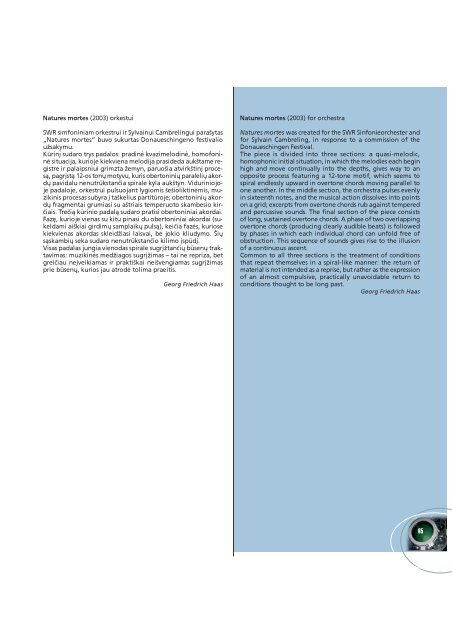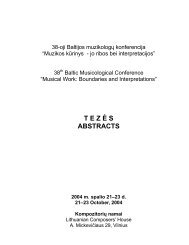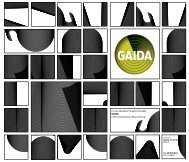2004 - Lietuvos Kompozitorių Sąjunga
2004 - Lietuvos Kompozitorių Sąjunga
2004 - Lietuvos Kompozitorių Sąjunga
Create successful ePaper yourself
Turn your PDF publications into a flip-book with our unique Google optimized e-Paper software.
Natures mortes (2003) orkestui<br />
SWR simfoniniam orkestrui ir Sylvainui Cambrelingui parašytas<br />
„Natures mortes“ buvo sukurtas Donaueschingeno festivalio<br />
uþsakymu.<br />
Kûriná sudaro trys padalos: pradinë kvazimelodinë, homofoninë<br />
situacija, kurioje kiekviena melodija prasideda aukðtame registre<br />
ir palaipsniui grimzta þemyn, paruoðia atvirkðtiná procesà,<br />
pagrástà 12-os tonø motyvu, kuris obertoniniø paraleliø akordø<br />
pavidalu nenutrûkstanèia spirale kyla aukðtyn. Viduriniojoje<br />
padaloje, orkestrui pulsuojant lygiomis ðeðioliktinëmis, muzikinis<br />
procesas subyra á taðkelius partitûroje; obertoniniø akordø<br />
fragmentai grumiasi su aðtriais temperuoto skambesio kirèiais.<br />
Treèià kûrinio padalà sudaro pratisi obertoniniai akordai.<br />
Fazæ, kurioje vienas su kitu pinasi du obertoniniai akordai (sukeldami<br />
aiðkiai girdimø samplaikø pulsà), keièia fazës, kuriose<br />
kiekvienas akordas skleidþiasi laisvai, be jokio kliudymo. Ðiø<br />
sàskambiø seka sudaro nenutrûkstanèio kilimo áspûdá.<br />
Visas padalas jungia vienodas spirale sugráþtanèiø bûsenø traktavimas:<br />
muzikinës medþiagos sugráþimas – tai ne repriza, bet<br />
greièiau neáveikiamas ir praktiðkai neiðvengiamas sugráþimas<br />
prie bûsenø, kurios jau atrodë tolima praeitis.<br />
Georg Friedrich Haas<br />
Natures mortes (2003) for orchestra<br />
Natures mortes was created for the SWR Sinfonieorchester and<br />
for Sylvain Cambreling, in response to a commission of the<br />
Donaueschingen Festival.<br />
The piece is divided into three sections: a quasi-melodic,<br />
homophonic initial situation, in which the melodies each begin<br />
high and move continually into the depths, gives way to an<br />
opposite process featuring a 12-tone motif, which seems to<br />
spiral endlessly upward in overtone chords moving parallel to<br />
one another. In the middle section, the orchestra pulses evenly<br />
in sixteenth notes, and the musical action dissolves into points<br />
on a grid; excerpts from overtone chords rub against tempered<br />
and percussive sounds. The final section of the piece consists<br />
of long, sustained overtone chords. A phase of two overlapping<br />
overtone chords (producing clearly audible beats) is followed<br />
by phases in which each individual chord can unfold free of<br />
obstruction. This sequence of sounds gives rise to the illusion<br />
of a continuous ascent.<br />
Common to all three sections is the treatment of conditions<br />
that repeat themselves in a spiral-like manner: the return of<br />
material is not intended as a reprise, but rather as the expression<br />
of an almost compulsive, practically unavoidable return to<br />
conditions thought to be long past.<br />
Georg Friedrich Haas<br />
65





